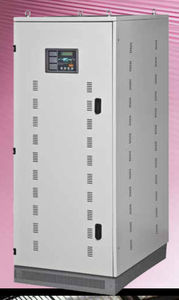
- Electricity - Electronics
- Power Supply
- On-line UPS
- PMI/OES Group
On-line UPS three-phaseindustrial
Add to favorites
Compare this product
Characteristics
- Type
- on-line
- Electrical characteristics
- three-phase
- Applications
- industrial
Description
Industrial UPSs are regarded as fully customized power supply systems for rugged environments and designed particularly to safeguard critical loads in industrial applications where voltage transients, created by degraded mains supply, can seriously damage both UPS and the critical load.
Industrial UPS Systems are fully flexible and customizable and designed for active–on line installation between the power source, by-pass source and critical load where the inverter delivers regulated AC voltage and frequency to the load and rectifier delivers regulated DC voltage / current to the DC load at all times without interruption.
The power conversion process isolates the critical load from the normal mains disturbances and isolates the mains from load induced reflected harmonics affecting other loads connected to the input mains feeder. The rectifier converts AC power into DC to charge lead acid or nickel cadmium batteries; it also provides the necessary DC for continuously rated capacity of the inverter. IGBT semiconductor modules are used in PWM inverter and the control logic creates the precise sinusoidal output waveform with a very low harmonic content. Thyristor semiconductor modules are also used in rectifier for reliable operation.
The system consists of rectifier / charger, inverter, static bypass, maintenance bypass, rectifier isolation transformer, inverter isolation transformer, bypass line isolation transformer, automatic line stabilizer, DC distribution, AC distribution, controls and monitoring.
Catalogs
No catalogs are available for this product.
See all of PMI/OES Group‘s catalogsRelated Searches
*Prices are pre-tax. They exclude delivery charges and customs duties and do not include additional charges for installation or activation options. Prices are indicative only and may vary by country, with changes to the cost of raw materials and exchange rates.


